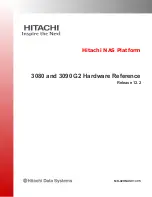
Signal and Transistor Descriptions
A-4
Copyright © 2001, 2004 ARM Limited. All rights reserved.
ARM DDI 0210C
A.3
Signal descriptions
Table A-3 describes all the signals used for the ARM7TDMI r4p1 processor.
Table A-3 Signal descriptions
Name
Type
Description
A[31:0]
Addresses
O
This is the 32-bit address bus.
ALE
,
ABE
, and
APE
are used to control
when the address bus is valid.
ABE
Address bus enable
IC
The address bus drivers are disabled when this is LOW, putting the address
bus into a high impedance state. This also controls the LOCK,
MAS[1:0]
,
nRW
,
nOPC
, and
nTRANS
signals in the same way.
ABE
must be tied
HIGH if there is no system requirement to disable the address drivers.
ABORT
Memory abort
IC
The memory system uses this signal to tell the processor that a requested
access is not allowed.
ALE
Address latch enable
IC
This signal is provided for backwards compatibility with older ARM
processors. For new designs, if address retiming is required, ARM Limited
recommends the use of
APE
, and for
ALE
to be connected HIGH.
The address bus,
LOCK
,
MAS[1:0]
,
nRW
,
nOPC
, and
nTRANS
signals
are latched when this is held LOW. This enables these address signals to be
held valid for the complete duration of a memory access cycle. For example,
when interfacing to ROM, the address must be valid until after the data has
been read.
APE
Address pipeline enable
IC
Selects whether the address bus,
LOCK
,
MAS[1:0]
,
nRW
,
nTRANS
, and
nOPC
signals operate in pipelined (
APE
is HIGH) or depipelined mode
(
APE
is LOW).
Pipelined mode is particularly useful for DRAM systems, where it is
desirable to provide the address to the memory as early as possible, to allow
longer periods for address decoding and the generation of DRAM control
signals. In this mode, the address bus does not remain valid to the end of the
memory cycle.
Depipelined mode can be useful for SRAM and ROM access. Here the
address bus,
LOCK
,
MAS[1:0]
,
nRW
,
nTRANS
, and
nOPC
signals must
be kept stable throughout the complete memory cycle. However, this does
not provide optimum performance.
See
Address timing
on page 3-14 for details of this timing.
BIGEND
Big endian configuration
IC
Selects how the processor treats bytes in memory:
•
HIGH for big-endian format
•
LOW for little-endian format.
Содержание ARM7TDMI
Страница 6: ...Contents vi Copyright 2001 2004 ARM Limited All rights reserved ARM DDI 0210C ...
Страница 10: ...List of Tables x Copyright 2001 2004 ARM Limited All rights reserved ARM DDI 0210C ...
Страница 14: ...List of Figures xiv Copyright 2001 2004 ARM Limited All rights reserved ARM DDI 0210C ...
Страница 46: ...Introduction 1 26 Copyright 2001 2004 ARM Limited All rights reserved ARM DDI 0210C ...
Страница 120: ...Coprocessor Interface 4 18 Copyright 2001 2004 ARM Limited All rights reserved ARM DDI 0210C ...
Страница 142: ...Debug Interface 5 22 Copyright 2001 2004 ARM Limited All rights reserved ARM DDI 0210C ...
Страница 276: ...Differences Between Rev 3a and Rev 4 C 6 Copyright 2001 2004 ARM Limited All rights reserved ARM DDI 0210C ...
Страница 282: ...Glossary Glossary 6 Copyright 2001 2004 ARM Limited All rights reserved ARM DDI 0210C ...
















































